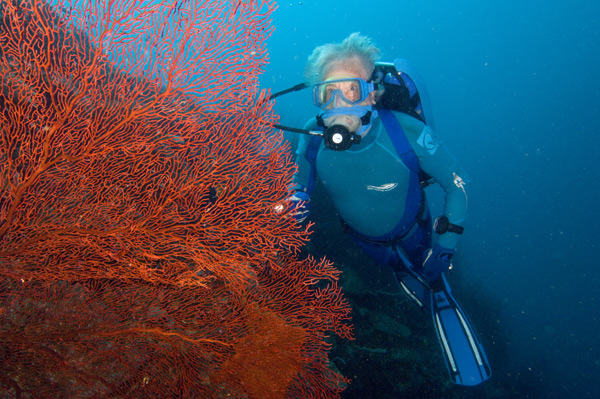Love is in the Sea

By Jean-Michel Cousteau
Far beneath the waves, glistening under the new moon, the mood strikes right for two fishes in love. Swimming side by side and holding tails, seahorses engage in a ritual of love that is both fascinating and magical. Seahorses, named for their “horse-like” head, are actually fish despite their peculiar appearance. In the name of love, these animals engage in a spectacular display of courtship. The male may spend days courting his truly beloved as the two swim tail in tail in a harmonious and majestic fashion. Such displays are believed to help the seahorses synchronize their movements with one another. They may also change colour during their ritual, varying between lighter and darker shades. Seahorses are well known chameleons of the sea, and can rapidly change color to camouflage themselves into their environment.
Mate For Life
Following these rituals, the two engage in a more formal courtship, where the male begins to display his brood pouch to his significant other. In their final display, the two release their hold from the sea grass and float toward the surface while the female deposits her eggs into the male. Then, a phenomenon not seen anywhere else in the animal kingdom occurs – the male becomes pregnant and carries the young through gestation and delivery.
Yet the love story of our seahorses is not over. Throughout the male’s pregnancy, which can range from two to five weeks, the female returns to the male each day and the two partake in a “morning greeting.” This ritual lasts for a couple minutes, where they dance alongside one another, reaffirming their bond. Upon finding a mate and forming this unique bond, many seahorse pairs mate for life. Following the next new moon, the courtship will recommence, and the cycle of life will begin once more.
However, in the wake of human development and expanding interests, seahorses face many new threats. Habitat destruction poses an immediate risk to many seahorse species.
The increasing demand for development along coastal areas has meant destruction for vital environments such as mangroves, sea grass beds, coral reefs and estuaries, all uniquely valuable ecosystems that animals such as the seahorse depend upon for survival. Since there is not sufficient data on seahorse populations and species, our impact on these animals is largely unknown. We still have time to learn more about these incredible animals without losing them from our planet.
Lovebirds
Among the sounds of squawking Albatross, a similar tale of love unfolds. After returning to land after their long months at sea, Albatross pairs must find one another amongst a crowd of potentially thousands of migrating seabirds. These lovebirds come from all corners of the ocean. Although they could spend their entire lives on the sea, hunting from the abundant ocean and sleeping atop the waves, there is one thing land can provide for them that water cannot: a place to breed.
Albatross are truly unique birds. They take many years to reach sexual maturity, more years to find a partner, and then spend an enormous amount of time and energy raising their young. They are among the largest of seabirds and although most have wingspans around five to six feet (1.5-1.8m), the largest of their species have wingspans of up to 11 feet (3m)! They are also extraordinary long-lived animals, living up to 50 years or more. When breeding season approaches, Albatrosses oftentimes return to their natal colony. It is here where humans have had the opportunity to observe their elaborate and beautiful breeding rituals.
Albatrosses are quite the romantics. Although a young bird may reach breeding age around five years old, they are not yet versed in the ways of the Albatross breeding dances. Young birds spend years observing and practicing the art of their ritual, learning from both mimicry of their elders as well as lots of trial and error. The dances are comprised of various synchronized behaviors such as bill clacking, staring, pointing, preening, and calling. Once they are able to recognize and respond correctly to the various behaviors, young Albatross begin the search for their soul mate. Though it may take years to find their perfect partner, Albatross will choose a single individual with whom they decide to share their life. Upon choosing one another, they engage in a beautiful and elaborate dance that becomes a language unique to each pair. Having established their bond, the Albatross pair will remain together for the rest of their lives.
Growing threats from overfishing, pollution, and habitat destruction continue to impact these magnificent birds. Of the roughly 22 Albatross species, 17 are listed as endangered. Long-line fishing practices have increased the number of Albatross killed, since many birds diving for fish mistakenly become hooked themselves. Pollution has also had detrimental effects on these seabirds, with plastics becoming lodged in their digestive tracts. Although we are at risk of loosing these beautiful animals, it is within our power to make a change.
In the midst of appreciating one another, we mustn’t forget the love we share with the Earth. Upon watching the picturesque seahorse dance or the elaborate mating ritual of the Albatross, it is easy to fall in love with all nature has to offer. Now we must stand up for the ocean; we must protect what we love.







